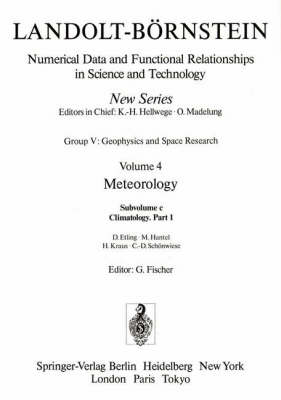Landolt-Boernstein: Numerical Data and Functional Relationships in Science and Technology - New
2 total works
4c2
Meteorology was first considered in Landolt-Börnstein in Volume III (published 1952) of the 6th Edition. At that time, nine contributions with 153 pages seemed enough. In the meantime, meteorology has experienced a worldwide boom owing to the growing interest in environmental problems. New observation and evaluation methods together with high performance computers have produced an ever increasing amount of data on the atmosphere, which are being exploited for weather and climate problems in various ways. In addition to the improved knowledge gained directly by these observations they are indispensable in the verification of the diagnosed and predicted atmospheric states obtained by mathematically based weather forecasting and climate models. Volume V/4 of the New Series covers the field of meteorology as the physics of the atmosphere in several subvolumes. The first, V/4 a "Thermodynamical and dynamical structures of the global atmosphere", appeared in 1986. It was followed by subvolume V/4 b dealing with the physical and chemical data of the atmosphere. Subvolume V/4 c is concerned with the physical and meteorological aspects of climate. The first part, V/4 c 1, presented here, contains contributions on climate definition, specific surfaces climates, climate variations, and the planetary boundary layer. The second part, V/4 c 2, will treat the present global surface climate and the mathematical and physical concepts of climate modelling.
3b
Oceanography
by E Fahrbach, H Franz, G. Gust, M. Hantel, J Meincke, P M]ller, M Rhein, W Roether, and J Willebrand
Published 24 November 1989
In the 6th edition of Landolt-Boernstein, the field of oceanography was incorporated into the volume on "Astronomy and Geophysics" (1952) and covered 116 pages. Since that time, the tremendous increase of knowledge and the growing significance of oceanography called for a new compilation which appears as Volume V/3 of the New Series. The topics dealt with in this volume belong to physical oceanography, a part of geophysics and physics. Two chapters on "Topography" and "Coastal Oceanography" represent peripheral areas, since they are more geographically oriented. On the other hand, they are very pertinent to the physics of the ocean. Due to the large amount of information covered, Volume V/3 is divided into three subvolumes with a total of some 1200 pages. Subvolumes a and c have already appeared. Subvolume a deals with the topography of the oceans, measuring techniques and instruments and the properties of sea water. Subvolume c contains chapters on ocean waves, upwelling regions, ice in the ocean and coastal oceanography. The present subvolume b covers the ocean circulation and the ocean turbulence.

